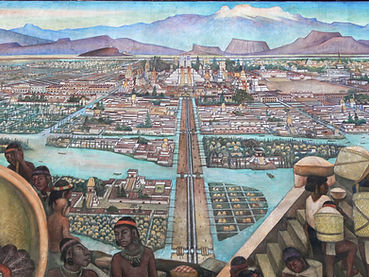Episode 2:
La Gran Tenochtitlan
The Aztec people who built the ancient city of Tenochtitlan – now Mexico City – proved themselves a highly competent and advanced civilization. Diego Rivera’s mural that imagines the ancient city at its peak, evokes wonder and pride by Mexican people about who the Aztecs were, and what else they could have achieved.
Ross Chambless: In the years after the Mexican Revolution, beginning in the 1920’s, Mexican authorities sought to teach new narratives about Mexico’s past to its people. Here is Susan Vogel, who is a scholar of Mexican art.

Susan Vogel: The government retained artists to paint the public walls of Mexico. A lot of people didn’t speak Spanish, but indigenous languages. This was an effort to use visual art to teach people the values of the Revolution.
Ross: One of the goals at this time was to honor Mexico’s indigenous heritage and not just the influence of the conquering Spanish empire from centuries before.
Susan: So Diego Rivera painted murals that showed the indigenous history of Mexico, and how amazing it really was. And how incredible these cities were. A lot of people didn’t know it at the time.

Ross: There are no photographs of ancient Tenochtitlan, of course. But there were visual representations of Tenochtitlan, made by the Aztecs, found in the codices. Diego Rivera had some of these to go on, but mostly it was his imagination.
Fanny Blauer: Many historians who had to write to the Kings in Spain described the city. I think Diego Rivera did a fantastic job in putting it all together in a piece of art. I remember specifically from the books I have read, how Cortés described the Temple of Moctezuma as this high pyramid, a white pyramid with different colors around it. It was a manifestation of what they believed. And how clean and organized the city was.
Ross: This is Nuevas Voces, Part 2, and in this episode, we are talking about Diego Rivera´s mural "The Grand Tenochtitlan". Tenochtitlan, now Mexico City, was built on a lake bed. That meant there was water everywhere.
Susan: So there’s all these islands, and causeways connecting the islands. There are urban areas, buildings, markets, people looking out over a balcony.

Ross: The Aztecs even engineered a series of floating islands for growing crops like maize, or corn, together with beans and squash: staples of the Aztec diet. The city also hosted a large marketplace.
Susan: The marketplace is bustling with people selling deer, feathers, minerals, fruits and vegetables, flowers, cacao (cocoa), and even gold.
Ross: The Aztec city even had its own medical center which included steam baths and a variety of herbs used as medicine.
Susan: It’s an extremely organized designed and engineered metropolis that probably had about 200,000 people at the time.

Ross: For Fanny and modern Mexicans, this representation of the ancient city has special meaning. Mexicans can even point to their own neighborhoods shown in Diego Rivera’s mural.
Fanny: I grew up in that area where the market was called Tlatelolco, it was the sister community of Tenochtitlan, which is only about two miles away. Still, there is a plaza there called "the three cultures", because you can see the remnants of pyramids and archeological sites where the market used to be. The church that was later built during colonialism, was made of the same stones of the pyramids destroyed. And in the 1960’s they built the first urban community as a city within the city. I am from there. I grew up with these three manifestations of my culture in one place.
Ross: For many, Rivera’s mural helps us to realize the complexity and advanced development of these indigenous cultures – something that has often not been taught – especially in the U.S.
Luis Lopez: For me, this painting is especially powerful. Growing up in the states, I didn’t get a lot of this history. It was really the first time I got to see the complexity of these cultures. I think that at this time period this city rivaled what was happening in Europe, which was why the Spanish were so astonished. They arrived thinking, ‘oh, we’re going to have these primitive beings’. But in some cases, they were equally or more advanced than us. Also, the fact that you have indigenous people painted here. I think most art that we see, that is valued, tends to be European. Here I see some beautiful brown faces. So as a Chicano, that definitely meant a lot to me. This is still one of my favorite paintings by Diego Rivera, that I still marvel at.
Ross: You can see a photograph of Diego Rivera's 1945 mural "The Grand Tenochtitlan", which today is found in the National Palace of Mexico City at our website and home of this podcast: www.artesmexut.org
~ ~ ~
Credits:
Thanks to our commentators Susan Vogel; Fanny Guadalupe Blauer; Luis Lopez; Episode produced and edited by Ross Chambless; Thanks to KCPW 88.3 FM for the studio space; Music credit: Ricardo Lozano and Jorge Ramos. This podcast is made possible thanks to Utah Humanities.
